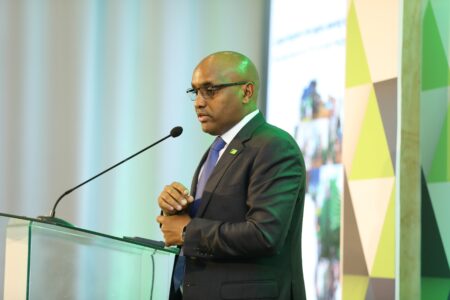- In 2021, 76 percent of adults had an account at a bank or regulated institution
- Financing will enable African nations to expand portfolio of digital financial solutions and initiatives
- The facility will be housed and managed by the African Development Bank,
India will contribute $2 million to the Africa Digital Financial Inclusion Facility (ADFI), in an effort to break the barrier to growth and spur uptake of digital financial solutions.
The facility will be housed and managed by the African Development Bank. It will mainly focus on accelerating financial inclusion in Africa, India said.
India is recognised globally for the success of its digital public payments system. The country’s collaboration with ADFI enables the facility to learn from best practices and help scale up initiative. The program aims to meet the needs of financially excluded and underserved people in Africa.
Africa yet to fully benefit from inclusion
Despite the growing evidence of digitization catalyzing sustainable development in Africa, recent data shows that nearly half the continent’s adult population does not benefit from digital financial solutions. Women, youth, farmers, small businesses and rural communities are especially excluded from inclusion.
Manisha Sinha, a Secretary in the Department of Economic Affairs and a key member of India’s ADFI Governing Council, mentioned that India’s unique Digital Public Infrastructure (DPI) presents learning chances within the digital finance sector. This model is both affordable and inclusive, fostering equity.
The DPI’s success in extending financial services to rural areas highlights India’s potential to collaborate within the ADFI partnership. Sinha emphasized the value of sharing expertise to enhance digital financial inclusion across the continent.
ADFI supports the African Development Bank’s Ten-Year Strategy focus on inclusive growth and the High five priority to Improve the quality of life for the people of Africa. Its role also aligns with the bank’s financial sector development department’s mandate to improve access to finance for the underserved.
ADFI works to scale innovative digital financial solutions under the three broad strategic pillars. These are infrastructure, policies and regulations and product innovation. Capacity building and gender inclusion cut across all interventions.
Financial inclusion on the continent is still low in some countries despite a sharp increase in the past 10 years.
Digital financial inclusion globally
A World Bank report The Global Findex Database 2021 shows that in 2021, 76 per cent of adults had an account at a regulated financial institution.
Globally, account ownership increased by 50 per cent between 2011 to 2021, rising from 51 per cent to 76 per cent of adults. From 2017 to 2021, the average rate of account ownership in developing economies increased by 8 percentage points. It increased from 63 percent of adults to 71 percent of adults.
In Sub-Saharan Africa, this expansion largely stems from the adoption of mobile money. Moreover, the gender gap in account ownership across developing economies has fallen to 6 percentage points. For a long time, this measure has been at nine percentage points, where it hovered for many years.
AfDB vice president for the Private Sector, Infrastructure and Industrialization, Solomon Quaynor, said the partnership will enable a learning experience from India’s digital public infrastructure success story.
This will enable African nations to expand portfolio of digital financial solutions and initiatives. It will also enhance the impact on greater economic empowerment, resilience and growth in the continent.
“We welcome the Government of India’s support of the catalytic role ADFI has been playing in accelerating greater access and usage of digital financial solutions and financial inclusion across the continent,” said Quaynor.










